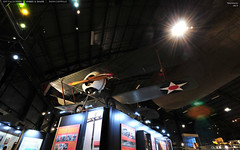The following screen captures explain what can be seen in the panorama:
 The French-built Nieuport 28 became the first fighter airplane flown in combat by pilots of the American Expeditionary Force (AEF) in World War I. The lightly built Nieuport 28 developed a reputation for shedding its upper wing fabric in a dive, and by the spring of 1918, many considered the Nieuport 28 obsolete. The less maneuverable, but faster and sturdier, SPAD XIII began replacing the Nieuport 28.
The French-built Nieuport 28 became the first fighter airplane flown in combat by pilots of the American Expeditionary Force (AEF) in World War I. The lightly built Nieuport 28 developed a reputation for shedding its upper wing fabric in a dive, and by the spring of 1918, many considered the Nieuport 28 obsolete. The less maneuverable, but faster and sturdier, SPAD XIII began replacing the Nieuport 28. The British Sopwith Camel F-1 shot down more enemy aircraft than any other World War I fighter. It was highly maneuverable and very difficult to defeat in a dogfight. Because of its tricky handling characteristics, however, more men lost their lives while learning to fly it than died while using it in combat. Partially hidden by the McCook Field Wind Tunnel one can see the black-striped Halberstadt CL IV. Introduced into combat during the last great German offensive of World War I, the CL IV supported German troops by attacking Allied ground positions.
The British Sopwith Camel F-1 shot down more enemy aircraft than any other World War I fighter. It was highly maneuverable and very difficult to defeat in a dogfight. Because of its tricky handling characteristics, however, more men lost their lives while learning to fly it than died while using it in combat. Partially hidden by the McCook Field Wind Tunnel one can see the black-striped Halberstadt CL IV. Introduced into combat during the last great German offensive of World War I, the CL IV supported German troops by attacking Allied ground positions. Tethered balloons, kike the Caquot Type R observation balloon, allowed World War I observers to see as far as 40 miles behind enemy lines to spot troop movements, chart trench systems and direct artillery fire. The observation balloon most used by Americans was named for its designer, French engineer Lt. Albert Caquot. The hydrogen-filled balloon could lift two passengers in its basket, along with charting and communications equipment, plus the weight of its mooring cable, to a height of about 4,000 feet in good weather.
Tethered balloons, kike the Caquot Type R observation balloon, allowed World War I observers to see as far as 40 miles behind enemy lines to spot troop movements, chart trench systems and direct artillery fire. The observation balloon most used by Americans was named for its designer, French engineer Lt. Albert Caquot. The hydrogen-filled balloon could lift two passengers in its basket, along with charting and communications equipment, plus the weight of its mooring cable, to a height of about 4,000 feet in good weather. n 1916 a new generation of German fighters threatened to win air superiority over the Western Front. The French aircraft company, Société pour l'Aviation et ses Dérives (SPAD), responded by developing a replacement for its highly successful SPAD VII. Essentially a larger version of the SPAD VII with a more powerful V-8 Hispano-Suiza engine, the prototype SPAD XIII C.1 ["C" designating Chasseur (fighter) and "1" indicating one aircrew] first flew in March 1917.
n 1916 a new generation of German fighters threatened to win air superiority over the Western Front. The French aircraft company, Société pour l'Aviation et ses Dérives (SPAD), responded by developing a replacement for its highly successful SPAD VII. Essentially a larger version of the SPAD VII with a more powerful V-8 Hispano-Suiza engine, the prototype SPAD XIII C.1 ["C" designating Chasseur (fighter) and "1" indicating one aircrew] first flew in March 1917. The Thomas-Morse S4C Scout became the favorite single-seat training airplane for U.S. pilots during World War I. Dubbed the "Tommy" by its pilots, the plane had a long and varied career. Tommies flew at practically every pursuit flying school in the United States during 1918. After the war ended, the Air Service sold them as surplus to civilian flying schools, sportsman pilots and ex-Army fliers.
The Thomas-Morse S4C Scout became the favorite single-seat training airplane for U.S. pilots during World War I. Dubbed the "Tommy" by its pilots, the plane had a long and varied career. Tommies flew at practically every pursuit flying school in the United States during 1918. After the war ended, the Air Service sold them as surplus to civilian flying schools, sportsman pilots and ex-Army fliers. Few aircraft have received the attention given the Fokker Dreidecker I triplane. Often linked with the career of World War I's highest scoring ace, Germany's Rittmeister Manfred von Richthofen (the "Red Baron"), the nimble Dreidecker I earned a reputation as one of the best dogfighters of the war.
Few aircraft have received the attention given the Fokker Dreidecker I triplane. Often linked with the career of World War I's highest scoring ace, Germany's Rittmeister Manfred von Richthofen (the "Red Baron"), the nimble Dreidecker I earned a reputation as one of the best dogfighters of the war.

No comments:
Post a Comment